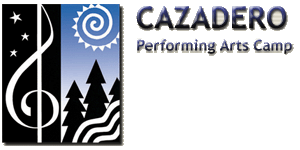Lesson Plans
First posted February 1, 2004 Last updated
June 19, 2009
These lesson plans are not rigid requirements, but
a starting point for the Nature Counselor's plan for
teaching a particular day's experience. The activity
should be fun and emphasize active learning on the student's
part: ask a question, don't just state a fact. If the
students do not get the answer, ask it again in a leading
manner ("Do you think redwood trees are special
because they are rare and grow so tall?"). You
should employ hands-on as much as possible. After all,
this is not the classroom: Cazadero is the laboratory!
We have the actual trees, flowers, plants, lichens,
bugs, whatever, not just the photographs of them. Be
sure to take every advantage of the fact that the session
is being held in the middle of the laboratory, and make
it as much hands-on as possible. Plan each session to
also allow time for making entries in the Nature
Journal.

YOUNG MUSICIANS (Grade Level
5-6-7-8)
Lesson Plan 1: The
Redwood Forest
Lesson Plan 2: Treasure
Hunt
Lesson Plan 3:
Leaves
Lesson Plan 4: Biozones
Lesson Plan 5: Bugs
of Cazadero
Lesson Plan 6: Cones
and Seeds
MIDDLE SCHOOL SESSION (Grade Level
6-7-8)
Lesson Plan 10: The Redwood Forest
Lesson Plan 11: To Be Announced
Lesson Plan 12: To Be Announced
JUNIOR HIGH SESSION (Grade Level
7-8-9)
Lesson Plan 20: The Redwood Forest
Lesson Plan 21: To Be Announced
Lesson Plan 22: To Be Announced
HIGH SCHOOL SESSION (Grade Level
9-10-11-12)
Lesson Plan 30: The
Redwood Forest
Lesson Plan 31: Redwood
Tree: Measuring the Height
Lesson Plan 32: Redwood
Tree: Measuring the Age
Lesson Plan 33: Redwood
Tree: How the Water Gets to the Top
Lesson Plan 34: Five
Kingdoms of Life
Lesson Plan 35: Five
Classes of Vertebrates
Lesson Plan 36: Fungi
Lesson Plan 37: Four
Groups of Land Plants
Lesson Plan 38: Ferns
Lesson Plan 39: Mosses

How
to Design a Lesson Plan
Eight Rearrangable Steps
1. Type of reasoning the student will do: (historical,
biological,etc...)
2. What is the issue/problem focus?(What are redwood
trees?)
3. What is the logic of student thinking? How will you
capture their interest? (ask questions)
4. What grouping arrangements will you use?
5. What sequence will the lesson follow? Which groups
will go when?
6. What mode of communication will the students be using?
Speaking, listening, reading, writing....
7. What tactics will you use to keep things running?.
8. What are the criteria and standards you will institute
for this lesson? Clarity, precision, relevance, accuracy,
significance, verifiability, etc.
The
Nature Journal


|

